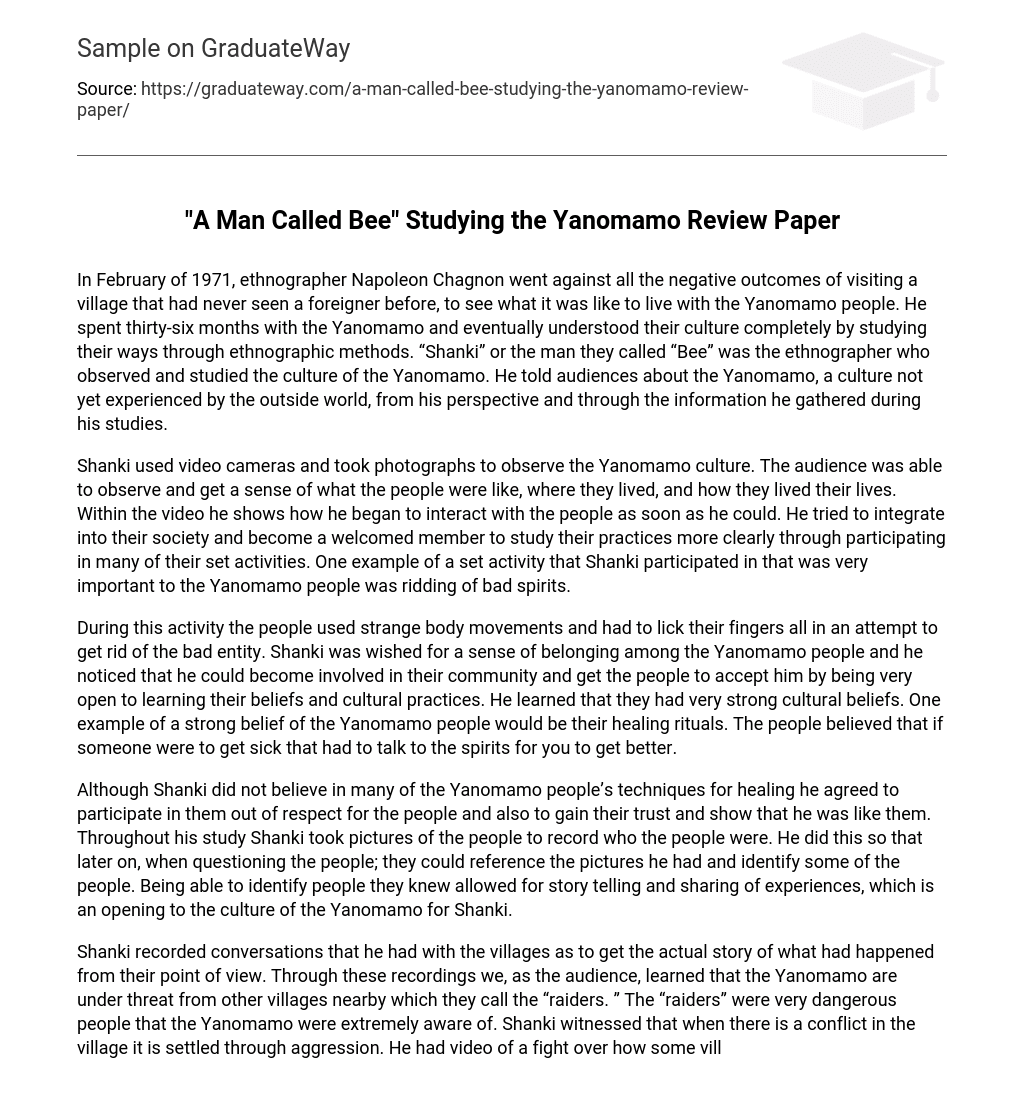In February of 1971, ethnographer Napoleon Chagnon went against all the negative outcomes of visiting a village that had never seen a foreigner before, to see what it was like to live with the Yanomamo people. He spent thirty-six months with the Yanomamo and eventually understood their culture completely by studying their ways through ethnographic methods. “Shanki” or the man they called “Bee” was the ethnographer who observed and studied the culture of the Yanomamo. He told audiences about the Yanomamo, a culture not yet experienced by the outside world, from his perspective and through the information he gathered during his studies.
Shanki used video cameras and took photographs to observe the Yanomamo culture. The audience was able to observe and get a sense of what the people were like, where they lived, and how they lived their lives. Within the video he shows how he began to interact with the people as soon as he could. He tried to integrate into their society and become a welcomed member to study their practices more clearly through participating in many of their set activities. One example of a set activity that Shanki participated in that was very important to the Yanomamo people was ridding of bad spirits.
During this activity the people used strange body movements and had to lick their fingers all in an attempt to get rid of the bad entity. Shanki was wished for a sense of belonging among the Yanomamo people and he noticed that he could become involved in their community and get the people to accept him by being very open to learning their beliefs and cultural practices. He learned that they had very strong cultural beliefs. One example of a strong belief of the Yanomamo people would be their healing rituals. The people believed that if someone were to get sick that had to talk to the spirits for you to get better.
Although Shanki did not believe in many of the Yanomamo people’s techniques for healing he agreed to participate in them out of respect for the people and also to gain their trust and show that he was like them. Throughout his study Shanki took pictures of the people to record who the people were. He did this so that later on, when questioning the people; they could reference the pictures he had and identify some of the people. Being able to identify people they knew allowed for story telling and sharing of experiences, which is an opening to the culture of the Yanomamo for Shanki.
Shanki recorded conversations that he had with the villages as to get the actual story of what had happened from their point of view. Through these recordings we, as the audience, learned that the Yanomamo are under threat from other villages nearby which they call the “raiders. ” The “raiders” were very dangerous people that the Yanomamo were extremely aware of. Shanki witnessed that when there is a conflict in the village it is settled through aggression. He had video of a fight over how some villagers were not sharing food.
The sharing of food is a big conflict for the Yanomamo people given that there is not much surrounding them and their lack of resources, therefore a disturbance in the food sharing norms could lead to major problems. The fights over food lead to serious injury or death and Shanki took no part within these conflicts to avoid creating problems between him and the villagers. Shanki’s recordings were somewhat personal; however throughout the film it appears as though the Yanomamo people id not mind the recording itself.
In my personal opinion the ethnographer wanted to give an in depth look on what it is like to live in a society that is so different from our own. In my research on the Yanomamo people and their relation to Shanki from his research I found an article on the Yanomamo culture. This article gave an example of a research in which ethnographers took a more specific approach as to learning the Yanomamo culture with specific look onto the social interaction between the people and the kinship levels. The study has many similar aspects to Shanki’s however this was a much more experimental research approach.
These ethnographers studied the same amount of males and females that Shanki did during his study. This study tested the villagers and saw what their reactions were whereas Shanki interacted among the villagers. This article gives a perspective of a different approach to seeing the reality of the Yanomamo culture. In my opinion Shanki was much more successful than the researchers from this study because Shanki was much more integrated into the culture and was able to better understand the Yanomamo people’s customs and ways. Shanki witnessed and lived the lives of the Yanomamo.
Shanki’s research has proven that the Yanomamo culture is very different from American culture. By watching the film and class and seeing it for myself, I was able to understand not only what it is like to be an ethnographer but also what the proper steps are to correctly study and understand a culture.
Works Cited
1. A Man Called “Bee”: Studying The Yanomamo, by Asch Timothy and Chagnon Napoleon, in Yanomamo (Documentary Education Resources (DER), 1974) 2. Fox, Robin. 1979. Kinship Categories. Evolutionary Biology and Social Behavior: Anthropological Perspective. William Irons, Pp. 132-144. North Scituate, MA: Duxbury Press.





